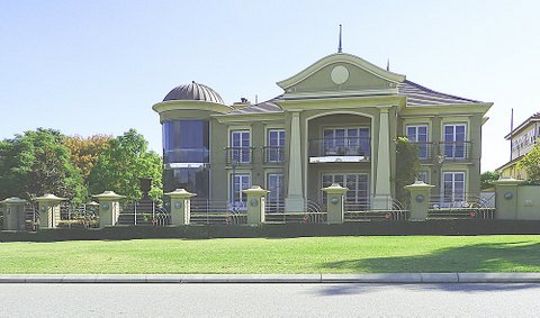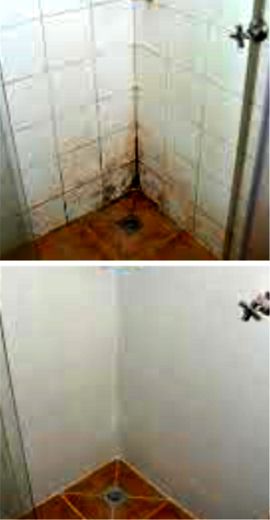Dampguard offers you cost-effective and long-lasting solutions to fix and prevent Rising Damp, Rain Penetration and Leaking Showers.
Solutions for

The Company
Dampguard WA was founded in 1984 and has solved damp wall issues in many buildings around Western Australia.
From a rammed-earth house in Margaret River to the shell church at Beagle Bay near Broome to houses, schools, offices and heritage buildings in Perth.
Dampguard WA has developed its own unique formulations and pursues a policy of continuous improvement. Our aim is to solve your damp problem permanently.

What You have to do
Remove any valuable items from harm's way. Provide reasonable access to work spaces (2 metres from wall).
Be aware that this is noisy and dusty. You may have to move children and pets for a while.
Rising Damp
All types of brick and limestone of any thickness can be treated. For rising damp we use the polymer injection process as used in the UK and Europe for over 50 years.
The product is DAMPGUARD DPC our own form of Oligomeric Polysiloxane which reacts with moisture in the masonry to form a permanent water-repellent polymer. It has a low odour, low toxicity and high alkaline resistance so that it remains stable in older masonry and limestone walls. It is UV-resistant and unaffected by temperature fluctuations.
We work from inside the building where the salt-damaged render/plaster is
removed. The brick or stonework is then drilled and injected to suit the
construction (not always under high pressure) to achieve total saturation of
the length and thickness of the treated wall creating a new and
permanent
Damp Proof Course (DPC).
Sometimes the cavity is blocked by fretting masonry and may need to be removed. Dampguard will inspect the cavity using our Inspection Camera. A small hole is drilled into the wall and a flexible camera head inserted into the hole will let us record any obstruction and debris in the cavity.
The standard 110 mm wall is left unplastered for between 4-12 weeks for the dampness to dry out. For thicker walls this may take several months. We then carry out a Dryness Check with a moisture meter and the walls can be replastered.
All effort will be taken to protect floors and furnishings with drop sheets and covers. PLEASE have your walls inspected before polishing your timber floors.

Rain Penetration
This occurs particularly in west-facing walls where the outer surface has deteriorated due to natural ageing. In cavity walls it can lead to rising damp where the cavity has become bridged by fretting mortar and debris. It is sometimes necessary to treat walls for rising damp and rain penetration. A survey would be required to solve these problems. Some solutions include repointing, crack repairs, sealing windows and cavity cleaning. The walls would then be sprayed with 3 coats of Dampguard Water Repellent.
Membranes
Membranes are mainly used under soil level to prevent ground water penetrating into areas such as basements. Buildings built into slopes can have problems in garages and store rooms. Where no Damp Proof Course was installed (older buildings) you can usually smell the damp and often see salt crystals on these walls. We use quality products from specialised manufacturers, often using a 2-pack epoxy followed by a flexible membrane coating. All care is taken to fill holes and repair cracks before the membrane is applied.

After We Leave
Please DO NOT use the shower for 24 hours on completion of the job.
Before first use of shower please rinse off with sponge and water.
After showering quickly dry recess to help keep your shower looking good and reduce the risk of mould.
Leaking Shower Recesses
An inspection of the shower recess is the first step. If work is needed, we remove the old grout, re-grout and then apply Dampguard Water Repellent to keep the recess looking good. The shower screen silicone is also replaced. If required, the walls damaged by the leaking recess would be treated in the same way as for Rising Damp.
What You Need To Do
Make sure there is no plumbing leak.
A full tap service is recommended.
Our consultant can give you some advice.
Please DO NOT use the shower 24 hours prior to work commencing.
Remove all loose items from the bathroom.
What We Do
Arrive on time as arranged. Cover floors and furniture with drop sheets (this is a messy job). We vacuum and dust to the best of our ability and remove the rubbish from the site.

Condensation
As we all know condensation is caused by warm moisture laden air coming into contact with a cold surface. The small droplets of water support the growth of black spot mould that only grows on condensation not on rising damp. However dampness in a room can cause condensation.
The source of condensation is usually a shower, clothes dryer, flueless gas heater or well used kitchen or laundry.
Clothes dryers should be ventilated to the outside and internal laundry doors kept closed during washing and drying operations to prevent moisture-laden air migrating to other parts of the house.
Bathrooms in particular should be used with the door closed the extractor fan on and if possible the window open and should be left this way for half an hour after use.
The Cure is Simple
- Remove or isolate the source of moisture.
- Increase ventilation in the affected area.
- If possible increase the temperature of the affected surfaces.
Building Inspections
If you're buying a house and have any worries about existing dampness in walls, please phone or email to arrange an appointment.
